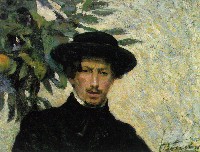Boccioni was trained from 1898 to 1902 in the studio of the painter Giacomo
Balla, where he learned to paint in the manner of the Pointillists. In 1907
he settled in Milan and gradually came under the influence of the poet Filippo
Marinetti, who launched the literary movement Futurism, which glorified the
dynamism of modern technology. Boccioni adapted Marinetti’s ideas to the
visual arts and became the leading theoretician of Futurist art. In 1910 he
and other painters drew up and published the Technical Manifesto of the Futurist
Painters, promoting the representation of the symbols of modern technology—violence,
power, and speed.
Boccioni enlisted in the army during World War I and was killed by a fall from a horse in 1916. He was the most talented of the Futurist artists, and his untimely death marked the virtual end of the movement.
(From Encyclopedia Britannica, www.eb.com)
